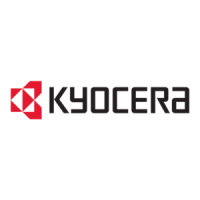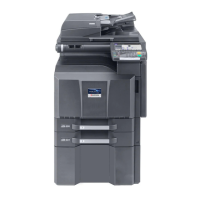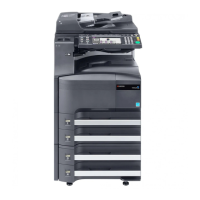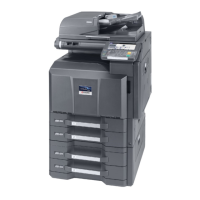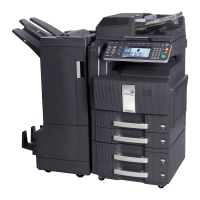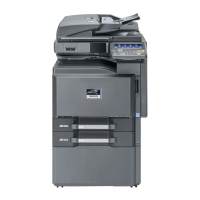Do you have a question about the Kyocera TASKalfa 5052ci and is the answer not in the manual?
Safety conventions, environment, precautions, warranty, legal restrictions, and energy saving.
Information on Class 1 laser product classification and potential exposure.
Information on laser beam safety standards and regulations in the USA.
Instructions on safely disconnecting the equipment from the power source.
Details FCC and Industry Canada compliance and operational conditions.
Limited warranty details for MFPs and accessories in the US and Canada.
Discusses security risks and precautions when using wireless LAN.
Details limitations and specific use cases for the product, especially regarding medical equipment.
Explains Low Power Mode and Sleep Mode for energy saving.
Identifies external parts of the machine with numbered labels.
Identifies internal connectors and parts with numbered labels.
Details how to connect the machine to PCs via USB or network.
Provides instructions for connecting LAN and USB cables.
Describes how to turn the machine on and off using the power switch.
Explains the keys and indicators on the operation panel.
Details the Home screen and its elements.
Procedures for logging into and out of the machine.
Explains how to configure default settings like date, time, and network.
Details how to configure network settings.
Explains Low Power Mode and Sleep Mode for energy saving.
Guides users through configuring FAX, paper, energy saver, and network settings.
Instructions for installing PC software from the DVD.
Instructions for installing software on a Mac computer.
Instructions for registering the machine to the TWAIN driver.
Instructions for registering the machine to the WIA driver.
Explains how to access and use Command Center RX for configuration and monitoring.
Explains the settings available in the printer driver properties screen.
General procedures for printing from a PC using the KX DRIVER.
How to save and print jobs from the Job Box.
How to monitor printer status using the Status Monitor utility.
How to load originals onto the platen or document processor.
Basic operations and procedures for making copies.
Describes methods for sending scanned documents, like email or to folders.
How to store scanned documents in a shared computer folder.
Explains how to use the FAX function, noting the optional FAX Kit.
Explains the functions of document boxes like Custom Box and Job Box.
Explains the various functions available and how to select them.
How to produce two-sided copies from one-sided or two-sided originals.
How to check the status of jobs being processed or waiting.
Procedures for managing jobs like pausing, resuming, canceling, and reordering.
How to check toner levels, paper status, and other supplies.
Explains how to configure settings related to overall machine operation.
Details all configurable settings within the System Menu.
Select whether to cancel or continue job when an error occurs.
Configures network settings.
Configure wired network settings.
Configure security settings for communication.
Explains how user access is administered and security levels.
How to enable user login administration and select authentication methods.
Registers, alters, and deletes users, and configures settings.
Explains how job accounting manages counts by assigning IDs to accounts.
Steps to enable job accounting for managing copy, print, scan, and fax counts.
How to add, change, and delete accounts and set restrictions.
Procedures for routine cleaning and maintenance.
Guidelines for solving common machine malfunctions.
Procedures for adjusting printing quality and performing machine maintenance.
Step-by-step instructions for clearing paper jams in various locations.
Information on paper sizes, types, and specifications.
Technical specifications of the machine and its components.
Safety conventions, environment, precautions, warranty, legal restrictions, and energy saving.
Information on Class 1 laser product classification and potential exposure.
Information on laser beam safety standards and regulations in the USA.
Instructions on safely disconnecting the equipment from the power source.
Details FCC and Industry Canada compliance and operational conditions.
Limited warranty details for MFPs and accessories in the US and Canada.
Discusses security risks and precautions when using wireless LAN.
Details limitations and specific use cases for the product, especially regarding medical equipment.
Explains Low Power Mode and Sleep Mode for energy saving.
Identifies external parts of the machine with numbered labels.
Identifies internal connectors and parts with numbered labels.
Details how to connect the machine to PCs via USB or network.
Provides instructions for connecting LAN and USB cables.
Describes how to turn the machine on and off using the power switch.
Explains the keys and indicators on the operation panel.
Details the Home screen and its elements.
Procedures for logging into and out of the machine.
Explains how to configure default settings like date, time, and network.
Details how to configure network settings.
Explains Low Power Mode and Sleep Mode for energy saving.
Guides users through configuring FAX, paper, energy saver, and network settings.
Instructions for installing PC software from the DVD.
Instructions for installing software on a Mac computer.
Instructions for registering the machine to the TWAIN driver.
Instructions for registering the machine to the WIA driver.
Explains how to access and use Command Center RX for configuration and monitoring.
Explains the settings available in the printer driver properties screen.
General procedures for printing from a PC using the KX DRIVER.
How to save and print jobs from the Job Box.
How to monitor printer status using the Status Monitor utility.
How to load originals onto the platen or document processor.
Basic operations and procedures for making copies.
Describes methods for sending scanned documents, like email or to folders.
How to store scanned documents in a shared computer folder.
Explains how to use the FAX function, noting the optional FAX Kit.
Explains the functions of document boxes like Custom Box and Job Box.
Explains the various functions available and how to select them.
How to produce two-sided copies from one-sided or two-sided originals.
How to check the status of jobs being processed or waiting.
Procedures for managing jobs like pausing, resuming, canceling, and reordering.
How to check toner levels, paper status, and other supplies.
Explains how to configure settings related to overall machine operation.
Details all configurable settings within the System Menu.
Select whether to cancel or continue job when an error occurs.
Configures network settings.
Configure wired network settings.
Configure security settings for communication.
Explains how user access is administered and security levels.
How to enable user login administration and select authentication methods.
Registers, alters, and deletes users, and configures settings.
Explains how job accounting manages counts by assigning IDs to accounts.
Steps to enable job accounting for managing copy, print, scan, and fax counts.
How to add, change, and delete accounts and set restrictions.
Procedures for routine cleaning and maintenance.
Guidelines for solving common machine malfunctions.
Procedures for adjusting printing quality and performing machine maintenance.
Step-by-step instructions for clearing paper jams in various locations.
Information on paper sizes, types, and specifications.
Technical specifications of the machine and its components.
| Duplex printing | Yes |
|---|---|
| Print technology | Laser |
| Maximum resolution | 1200 x 1200 DPI |
| Time to first page (black, normal) | 3.7 s |
| Time to first page (color, normal) | 4.8 s |
| Print speed (black, normal quality, A3) | 25 ppm |
| Print speed (color, normal quality, A4/US Letter) | 50 ppm |
| Copier resize | 25 - 400 % |
| Maximum copy resolution | - DPI |
| Maximum number of copies | 999 copies |
| Scan to | E-mail, FTP, SMB, TWAIN, USB |
| Scanner type | Flatbed & ADF scanner |
| Scan speed (color) | 180 ppm |
| Image formats supported | JPG, MMR |
| Document formats supported | |
| Optical scanning resolution | 600 x 600 DPI |
| Faxing | Mono faxing |
| Modem speed | 33.6 Kbit/s |
| Fax coding methods | JBIG, MH, MMR (Fax coding method), MR |
| Digital sender | - |
| Maximum duty cycle | - pages per month |
| Page description languages | PCL 5c, PCL 6, PostScript 3, TIFF, XPS |
| Duplex media weight | 64 - 256 g/m² |
| Paper tray media weight | 52 - 300 g/m² |
| ISO A-series sizes (A0...A9) | A3, A4 |
| Maximum ISO A-series paper size | A3 |
| AC input voltage | 220 - 240 V |
| AC input frequency | 50 - 60 Hz |
| Power consumption (ready) | 60 W |
| Power consumption (sleep) | 1 W |
| Power consumption (average operating) | 860 W |
| Internal memory | 4 MB |
| Internal storage capacity | 328 GB |
| Paper input type | Paper tray |
| Total output capacity | 500 sheets |
| Maximum input capacity | 7150 sheets |
| Multi-Purpose tray input capacity | 150 sheets |
| Cabling technology | 10/100/1000Base-T(X) |
| Security algorithms | SNMPv3 |
| Ethernet LAN data rates | 10, 100, 1000 Mbit/s |
| Standard interfaces | Ethernet, USB 2.0 |
| USB 2.0 ports quantity | 4 |
| Display | LCD |
| Control type | Touch |
| Product color | Black |
| Display diagonal | 9 \ |
| Market positioning | Business |
| Mac operating systems supported | Mac OS X 10.8 Mountain Lion, Mac OS X 10.9 Mavericks |
| Depth | 665 mm |
|---|---|
| Width | 602 mm |
| Height | 790 mm |
